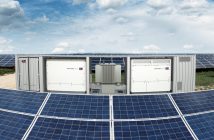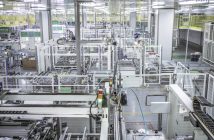- Alion Energy’s single-axis tracker racking product was originally designed to be deployed in regions where heavy installation equipment was more challenging to access, but labor might be more available.
- One aspect of this design philosophy is that the system is light and can be easily carried and assembled, and doesn’t require metal pilings to be driven deep into the ground.
- And interestingly, this carries over to commercial rooftops.
Mark Kingsley, Alion Energy CEO, said in a post on LinkedIn that a commercial real estate group had installed a standard rooftop, 10-degree fixed tilt monofacial solar array, as well as a competing Alion Energy system.
The results were as expected – 37.5% greater generation on a per watt basis from the single-axis tracker, on a pristine white thermoplastic roof versus standard modules. Of course, the real breakthrough is that they were able to get single-axis trackers installed on a commercial rooftop at all.
The rooftop in their example has a lot of skylights, and the overall structure is not facing due south. In this configuration, Alion Energy suggests that it can fit 4.55 MW of modules on the Maryland structure with a standard 10-degree installation. This system is projected to generate 1.34 kWh per watt each year.
Alion has designed a system that is 5.4 MW – a full 18% increase in wattage due to systems ability to be installed directly over skylights without needing the standard setback. Additionally, this hardware is projected to generate 1.54 kWh per watt installed per year.
In this case, that works out to 37% more electricity from the same rooftop. And when the trackers are directly attached to the roof – a 2.15 pounds per square foot dead load. Add in one Alion’s customized robotic cleaners, and the company says the levelized cost of electricity from the system falls to 4.67¢/kWh and generates 40% more electricity than a standard rooftop solar install.
And while this rooftop was selected to show off their hardware, it’s still an interesting best case scenario for us to consider.
Author: John Fitzgerald Weaver
This article was originally published in pv magazine and is republished with permission.










